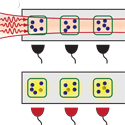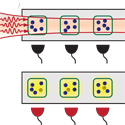Out of many atoms, one photon
Devices that count discrete quanta of light could be the building blocks of sophisticated quantum circuits. Most such counters based on single atoms register a photon only half the time, but in a paper appearing in Physical Review Letters, Jens Honer at the University of Stuttgart, Germany, and his colleagues propose a theoretical multi-atom system that could do the job with a nearly success rate.
Honer et al.’s idea takes advantage of interactions between Rydberg atoms confined to a small trap. In a Rydberg atom, at least one valence electron is in a highly excited state, circling the nucleus with a large radius that mimics a classical orbit. These excited state atoms interact strongly with one another, such that one Rydberg atom in a trap can block other atoms from being excited—an effect called Rydberg blockade.
Honer et al. consider atoms in a trap, which behave as a sort of superatom. The superatom has excited states, with one Rydberg excitation collectively shared among the atoms. Only one of these excited states interacts with light like a two-level system, while states remain dark. By introducing a second light field that causes dephasing, Honer et al. show that with large fidelity the superatom ends up in one of these dark states, and consequently greatly enhances the chance of photon absorption. At the same time the Rydberg blockade prevents the absorption of multiple photons within one such atom trap.
A series of these atom trap devices could, according to Horner et al., be used to count the photons in a few-photon light stream. – Jessica Thomas





